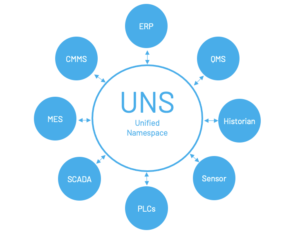Unified Namespace and Data Management
A Transformative Concept for IT/ OT Integration
As industries strive to bridge the gap between operational technology (OT) and information technology (IT), they often struggle with creating an implementation approach that provides full end-to-end supply chain visibility.
Integrating OT systems with IT platforms can be complex. OT devices generate vast amounts of data that are often unstructured, fragmented, proprietary and not easily integrated with IT architectures. This requires real-time data management and analytics that can scale to provide insights for informed decision making.
Historically, machines and software systems function independently, each utilizing their own unique data format or naming convention. This isolation results in inefficiencies and communication issues, often creating roadblocks for organizations looking to scale initiatives or integrate new technologies.
Where Does Unified Namespace Fit In?
Unified Namespace emerges as a critical component for this type of seamless integration. Since it was first created in 2005 by Walker Reynolds, Unified Namespace (UNS) is a term that has gained traction among controls engineers and enterprise solution architects. UNS is a model, rather than a software, for how to structure, organize and access data across an entire enterprise.

This viewpoint explores how UNS serves as the foundation for digital transformation initiatives, enabling real-time visibility, advanced analytics, and autonomous operations. We examine its evolution, implementation approaches, and the compelling business case for immediate adoption. Through a detailed maturity model and real-world case study, we provide a roadmap for organizations at any stage of their UNS journey.
What is Unified Namespace?
UNS is often defined as a centralized data repository or a mechanism to unify data across diverse systems. It acts as a "single source of truth," enabling real-time access to information from various sources. However, this traditional definition only scratches the surface.
UNS is more than just a data aggregator or tool; it is a dynamic system and strategic approach that ensures data is available, consistent, and accessible across both OT and IT layers, empowering organizations to derive actionable insights.
As IIoT University put it, think of it as a universal language or a common paper where all data across a company's business, including various systems, machines, and processes, is written, making it accessible and understandable to anyone, anything, and any part of the business.
What is Data Maturity?
The concept of data maturity provides an essential context for understanding UNS. As organizations progress in their digital transformation journey, data maturity signifies their ability to collect, manage, analyze and utilize data effectively. Including a data maturity framework helps identify where UNS fits into the broader picture, as it becomes an enabler for leveraging data at higher maturity levels.

Why UNS is Applicable in the OT Space
The OT environment has long been siloed, with systems designed for specific tasks operating independently. UNS addresses this fragmentation by creating a unified data architecture.
It’s interesting to note how UNS in the OT space mirrors IT’s evolution. In recent years, IT adopted enterprise service buses (ESB) and enterprise resource planning (ERP) systems to replace point-to-point integrations with centralized hubs for data exchange. Eventually, Master Data Management (MDM) systems emerged for important data domains such as customer, vendor and employee information to promote a single source of truth as this data is used across a variety of systems. OT is undergoing a similar transformation, leveraging UNS to facilitate data flow at the operational level.
By expanding IT management concepts into OT, organizations can:
- Improve the usability of data by making it accessible across the enterprise in a standardized format.
- Enhance decision-making through real-time data sharing.
- Optimize processes by enabling interoperability between OT and IT systems.
These benefits make UNS a cornerstone for integrating OT into broader enterprise strategies. By providing a unified framework, UNS ensures that data is not just collected but contextualized and actionable.
The Need for a Holistic Approach
The promise of UNS is significant, but achieving its full potential demands a clear understanding of its limitations and supplementary efforts to bridge the gaps. Many organizations hold misconceptions about UNS’s capabilities or aren’t set up for success, which can lead to unrealistic expectations.
For example, some believe UNS can automatically translate raw data into a business common language. In reality, this requires significant effort and additional tools. Others overestimate its functionality, expecting it to do more than its intended purpose as a pass-through system.
Effective deployment of UNS also relies on robust software solutions. The choice of software plays a critical role in ensuring that UNS integrates seamlessly with existing systems without conflicting with product strategy.
It’s important to consider the approach an organization is taking when implementing UNS and how that plays a role in their success factor. By aligning UNS concepts with the organization’s overall goals, businesses can avoid potential pitfalls and enhance the value of their investment.
Organizations must move beyond traditional UNS implementations to embrace a broader vision of data quality, integration and utilization.
A holistic approach to industrial data opportunities is essential. UNS must go beyond being a mere conduit; it should support the integration and contextualization of data to generate insights that drive business outcomes. This comprehensive perspective includes combining data from various sources, positioning industrial data opportunities as a strategic asset.
UNS provides a well-structured naming hierarchy and leveraging the ISA-95 hierarchy into the naming conventions makes it intuitive for systems to be designed for the factory floor with appropriate filters for data at the application layer based on lines or other specific metrics.
Designing a naming structure and establishing the foundation for the data model enables the system to maintain consistent data naming across diverse equipment, making integration and access to information and industrial context much smoother.
Considerations for Implementation
- Legacy OT System Integration: Ensure that legacy Operational Technology (OT) systems can support the protocols required for integration into a Unified Namespace (UNS) hub. Plan ahead for the use of intermediate gateways to translate legacy protocols such as BACnet and Modbus.
- Redundancy and Reliability: Design the UNS hub with appropriate redundancy and failover mechanisms to avoid it becoming a single point of failure.
- UNS as a Foundation: Treat the UNS as an architectural framework that lays the foundation for future development. Implementing the UNS is just the beginning—additional design and development are needed to support specific use cases aligned with the Publish/Subscribe model.
- Use Case Prioritization: Identify and deploy one or two high-priority use cases early to quickly demonstrate value and validate the architecture.
- Database-Centric Approach: Adopt a database-centric view of the UNS to enable fast lookups and queries of time-series data. This ensures that applications and use cases can quickly access relevant contextual information.
Five Steps to Do Tomorrow
In today's rapidly evolving industrial landscape, the question isn't whether to implement a Unified Namespace, but rather how quickly you can deploy one before competitors gain an insurmountable advantage. Several converging market forces make UNS implementation an urgent priority rather than a future consideration.
The time for UNS implementation is now. Organizations that establish a unified data foundation today will gain significant competitive advantages, while those that delay risk falling irreparably behind as the digital gap widens. This document provides the strategic framework and tactical guidance to begin your UNS journey immediately.
Unified Namespace represents a transformative concept for integrating OT and IT systems. By addressing data maturity, leveraging lessons from IT’s evolution, and adopting a holistic approach, organizations can unlock the true potential of UNS. However, success requires realistic expectations, strategic planning and a commitment to bridging gaps in traditional implementations.
Having a partner with expertise in both IT and OT integration can be a key differentiator for organizations. The journey to a successful Unified Namespace implementation doesn't have to begin with massive infrastructure changes. Here are five concrete steps you can take immediately to start your UNS journey:
1. Assess Your Current Data Architecture and Identify Integration Points
- Action: Conduct a comprehensive inventory of your existing OT and IT systems, documenting data sources, formats, and current integration methods.
- How to do it: Create a visual map of your current data landscape, identifying critical systems, data flows, and pain points. Focus on high-value data sources that impact operational decision-making. Document which systems need to communicate but currently cannot do so efficiently.
- Expected outcome: A prioritized list of integration points based on business impact and technical feasibility, with identified data silos that are prime candidates for UNS integration.
2. Establish Data Standards and Naming Conventions
- Action: Develop standardized naming conventions and data models that will serve as the foundation for your UNS.
- How to do it: Form a cross-functional team with representatives from both IT and OT. Define naming conventions that are intuitive, scalable, and aligned with industry standards where applicable. Create a data dictionary that documents these standards and share it across the organization.
- Expected outcome: A documented set of naming conventions and data models that will ensure consistency as you implement UNS, reducing future integration challenges and enabling seamless data exchange.
3. Select Appropriate Middleware and Integration Technologies
- Action: Evaluate and select the middleware technologies that will form the backbone of your UNS implementation.
- How to do it: Assess MQTT brokers, OPC UA servers, and other integration platforms based on your specific requirements. Consider factors such as scalability, security, performance, and compatibility with existing systems. Develop a proof of concept using a small subset of data to validate your technology choices.
- Expected outcome: A technology stack decision with justified selections for each component of your UNS architecture, including brokers, servers, and integration tools.
4. Implement a Pilot Project with Measurable Outcomes
- Action: Launch a focused pilot project that connects a limited number of systems through your nascent UNS.
- How to do it: Select a specific use case with high visibility and measurable impact. For example, connect one production line's equipment data to a quality management system. Define clear KPIs such as reduction in manual data entry, improvement in data accuracy, or decrease in decision latency.
- Expected outcome: A working proof of concept that demonstrates tangible benefits, builds organizational confidence, and provides lessons for scaling. Document baseline metrics before implementation and measure improvements after completion.
5. Develop a Scaling Strategy with Governance Framework
- Action: Create a roadmap for expanding your UNS implementation across the enterprise with proper governance controls.
- How to do it: Based on pilot results, develop a phased approach for expanding UNS to additional systems and facilities. Establish a governance committee responsible for maintaining data standards, approving changes to the namespace, and ensuring security compliance. Create documentation and training materials to support wider adoption.
- Expected outcome: A comprehensive scaling plan with clear phases, responsibilities, and governance mechanisms that will guide your organization through full UNS implementation while maintaining data integrity and security.
By following these five steps, you'll move beyond conceptual discussions of UNS and begin making tangible progress toward a unified data environment. Each step builds upon the previous one, creating momentum while delivering incremental value. Remember that successful UNS implementation is not just a technical challenge but also requires organizational alignment and change management to realize its full potential.
As industries embrace UNS, the focus should be on creating a unified, accessible and actionable data environment that drives business outcomes. By doing so, organizations can position themselves at the forefront of the digital transformation wave, harnessing the power of data to achieve operational excellence.
The time to act is now. With each passing month, the gap between digital leaders and laggards widens. Organizations that implement UNS today will not only solve current operational challenges but also build the foundation for future innovations that will define industry leadership in the coming decade.
Begin your UNS journey today, and transform your organization from data-challenged to data-driven.




